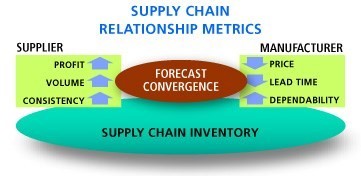Forecasting Information Hub Drives Supply Chain Efficiency
 From a manufacturer’s perspective, the effectiveness of relationships with suppliers usually nets out to be a function of price, availability and dependability (quality times on-time delivery). From a supplier’s perspective, the effectiveness of relationships with manufacturers comes down to profit, volume and consistency (order patterns).
From a manufacturer’s perspective, the effectiveness of relationships with suppliers usually nets out to be a function of price, availability and dependability (quality times on-time delivery). From a supplier’s perspective, the effectiveness of relationships with manufacturers comes down to profit, volume and consistency (order patterns).
More and more, information plays a key role in optimizing these elements not only for the manufacturer, but for the supplier as well. In a reasonably stable supply chain environment, forecast convergence between the manufacturer and supplier can drive significant improvements in these relationship metrics. If the supplier adds inventory, lead time and availability will improve. However, the additional inventory (even Vendor Managed Inventory) will ultimately increase the price of the procured products for the manufacturer in the end. At the core, dependability means meeting delivery commitments or reducing the variation of actual vs. committed delivery time with the required quality. This will drive reductions in the manufacturer’s raw material and finished goods inventory.
Forecast convergence is the common factor that will positively impact both supplier and manufacturer. So what is Forecast Convergence? It is the process of continuously improving the common view of purchase requirements using a collaborative forecasting information hub. This hub is a secure web-based information exchange that enables suppliers and manufacturers to compare and manage order forecasts on an exception basis. Improvements come from the simple, but effective, process of sharing each other’s view on the same forecast and managing the significant differences.
As a part of the forecasting information hub, an alert management system provides email notification when user-defined conditions are exceeded. An example is an alert to compare manufacturer and supplier item-level order forecasts that differ by more than a predetermined acceptable limit. For every item that fails the test, a notification is sent to an email distribution list, which in turn through an iterative process will drive convergence.
The results can be significant on the supply side.
- Purchased material fill rates will improve.
- Item level forecasts error will be reduced.
- Stock outs will decrease.
- Inventory excess across the supply side of the chain will be reduced.
The benefits are important to both Supplier and Manufacturer.
- The manufacturer will realize lower purchased material costs.
- Shorter lead times and the resulting lower inventories will be recognized by both manufacturer and supplier.
- Supplier relationships will be more profitable.
- Suppliers will realize more predictable demand patterns, allowing for more efficient use of resources and lowered operating costs.
Collaborative forecasting has its obvious advantages, but making it work for all parties involved is difficult. The challenge is creating an easy to use and flexible information platform that can produce significant results quickly with minimal investment. Today, a pre-built information facility like Silvon Stratum exists and can work effectively where manufacturers and suppliers collectively see the value of collaboration.
